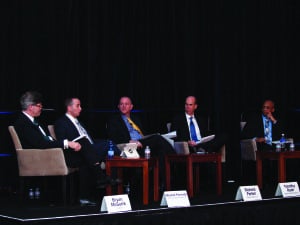
Panelists at Tuesday’s SATELLITE 2015 panel, “Spacecraft Repurposing Debate: Proponents and Skeptics Go Head-to-Head.” Photo: Vincent Lim.
[Via Satellite 03-18-2015] The long since thought of but yet to be commercialized in-orbit servicing industry is now closer to becoming a reality than ever before. ViviSat, a joint venture supported by Orbital ATK and US Space, has signed a pivotal customer for its Mission Extension Vehicles (MEVs), tipping the scale from buildup to actual implementation.
“We now have four MEV’s signed with clients. That puts us in a situation where we have the critical mass necessary for financing and to carry forward,” Bryan McGuirk, COO of ViviSat said during the “Spacecraft Repurposing Debate: Proponents and Skeptics Go Head-to-Head” panel at SATELLITE 2015.
As of the summer of 2014, ViviSat had three customers committed to in-orbit servicing using MEVs, with the driving rationale being to test out new orbital slots for future satellites. McGuirk said three of the four clients intend to use the MEVs to provide this service.
Now that a decisive number of customers has been reached, ViviSat plans to begin dual launching two MEVs at a time, with missions lasting five years at a time before the end of the decade. MEVs have a mission lifespan of approximately 16 years and sport longer antennas and arrays to better dock with spacecraft. The vehicles also use electric propulsion.
The fact that ViviSat reached a turning point in its project heavily influenced the debate, but skeptics still raised valid concerns regarding whether or not in-orbit servicing will actually be economically viable. David Belcher, a researcher at Futron, an Avascent company, cited dual-use concerns, as a device that can augment a satellite while in orbit could also perform more nefarious activities, making them a concern and/or a must-have for militaries.
“I have my doubts because I believe that every country with a capability of doing this is going to attempt to gain this technology. Because it is dual use, and I don’t see it as a global market; I see it as being fragmented as each country is fundamentally incentivized to have their own operators being serviced,” said Belcher.
Government operators of in-orbit servicing vehicles, or any spacecraft that can dock with another, pose a competitive threat to budding commercial ventures. Furthermore, both Lockheed Martin and Sierra Nevada Corporation (SNC) have proposed vessels for NASA’s Commercial Resupply Service 2 (CRS-2) contract that include spacecraft servicing features. Meidad Pariente, CTO of Effective Space Solutions (ESS), however, was quick to dismiss fears that the market could quickly become oversaturated.
“Two companies or even four companies will not be able to cater to the entire satellite operator community,” he said.
ESS plans a fundamentally different approach than that of ViviSat. Its spacecraft, the first of which is known as Deorbiter 1, have five-year lifespans, and can conduct a series of one-year missions or a single four-year mission. Services include station keeping, orbit corrections and relocations, and are paid for by continued revenues stemming from previously unavailable longevity. ESS intends to orbit a constellation of 20 to 25 servicing satellites.
Pariente said the first mission will likely focus on salvaging a satellite in an inclined orbit sometime in the 2017 to 2018 timeframe. He admitted the company has not signed with any operators yet, but attributed this to the lack of a launch vehicle, not a lack of interest. Once ESS commits to a launch date, contracts should soon follow, according to Pariente, given a robust amount of customer interest.
But beyond competition, regulations threaten to stifle in-orbit servicing developments, too.
“The problem comes in when you have satellites with U.S. components, which by cost is about 33 percent,” explained Belcher. “Those components are subject to U.S. export controls. ITAR licenses expire at launch, meaning you have to go through the process again if you want to image those components and send VSAT information down.”
Docking mechanisms require cameras and because they can see the Earth, the U.S. government requires them to have a commercial remote sensing license. ViviSat already has the necessary license, which extends to customers seeking to use MEVs for their hosted payload opportunities. McGuirk countered the regulatory argument, saying that working with U.S. agencies has actually been easier than expected.
“From a regulatory point of view we have been working with all the key regulatory bodies in the United States … everywhere from the State Department to the FAA to FCC to NOAA have been extremely proactive and willing to work with us, having a ‘can do’ attitude to work with us. I’m very pleased with what I found and, honestly, it’s been refreshing,” he said.
Furthermore, Pariente said an internal ESS study found a number of markets outside of the U.S. already have in-orbit servicing covered in their space laws.
Panelists also debated the actual necessity of these kinds of services. While the U.S. space shuttle mission to repair the Hubble Space Telescope remains iconic, and the 1992 rescue of Intelsat 603 kept that satellite in orbit until recently this year, a real impetus for these services has been notably absent.
“It’s hard to say that it is necessary. I think the industry has thrived without it. The exceptions have been select missions … so I think that operators are very skilled, very resourced and have done an outstanding job building their businesses without these resources,” said Timothy Rush, senior vice president of Marsh Space Projects.
But Pariente was quick to retort. “Not all satellite operators are ‘Big Four,’” he said. “There are a lot of medium and small satellite operators. Losing one satellite can be catastrophic for some operators.”
The post New Contracts Add Fuel to In-Orbit Servicing Advocates appeared first on Via Satellite.